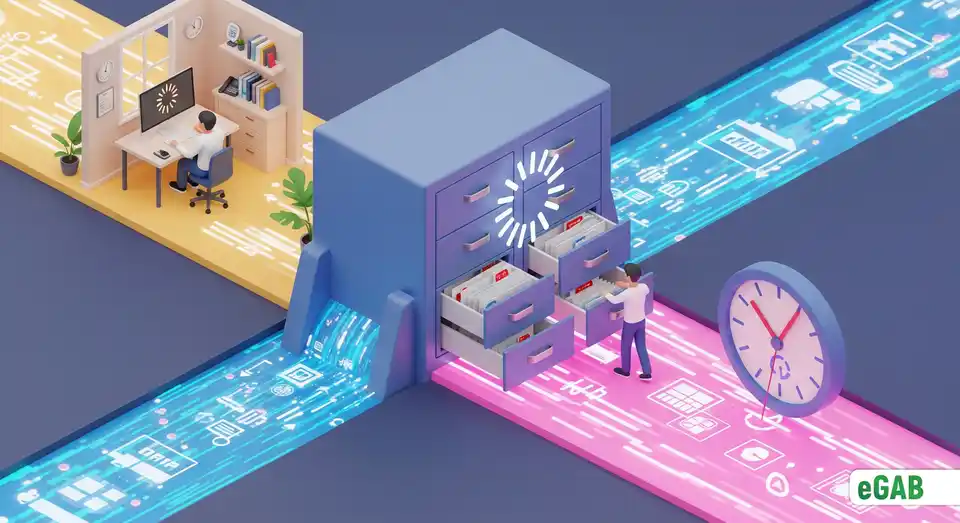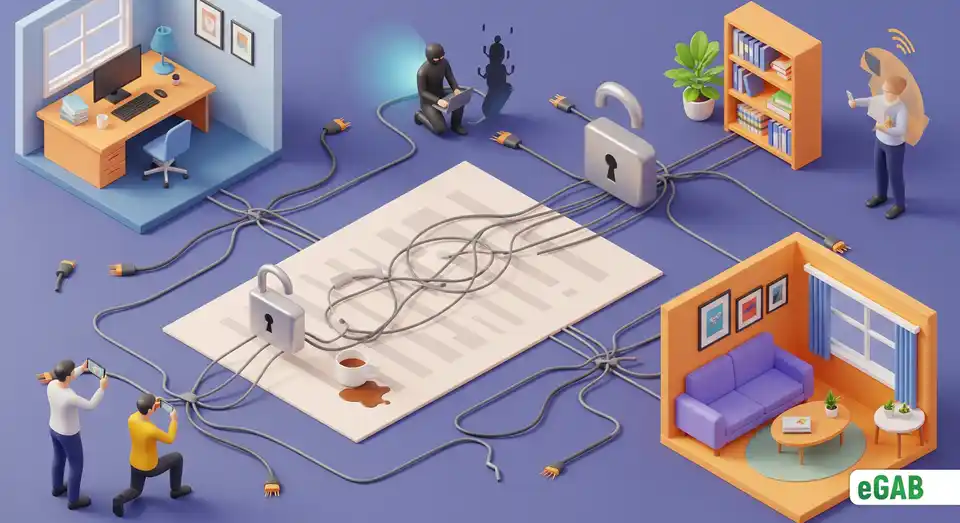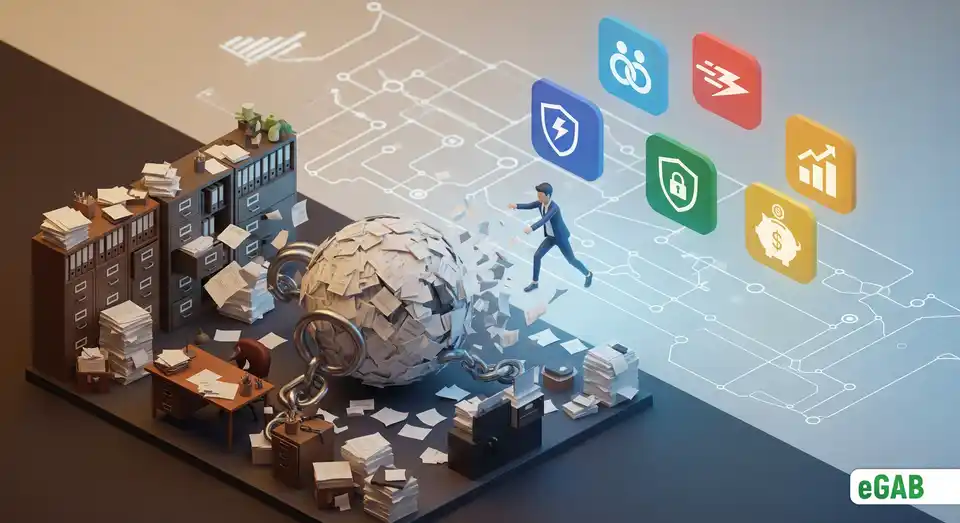Why Your Paper-Based Office is Failing Your Remote Team

 Author:
Artem Grigoriev
Author:
Artem Grigoriev
- How Do Physical Documents Prevent Effective Remote Collaboration?
- Why Does Centralized Paperwork Create Crippling Delays?
- What Are the Security Risks of Managing Paper With a Distributed Workforce?
- How Does a Paper System Drive Up Hidden Operational Costs?
- How eGAB Empowers a Truly Secure and Efficient Remote Workforce
- Summary: Escaping the Paper Trap to Unlock Remote Productivity
You’ve likely invested heavily in building a modern, agile remote team. You've even equipped them with the best digital collaboration tools. So why does everything still grind to a halt? Often, it’s because you're waiting for a physical signature. Or for a file that’s locked away in an office cabinet. This frustrating disconnect is what happens when your digital-first team is forced to operate on an analog, paper-based foundation.
The simple truth is, a paper-based office is failing your remote team . Its physical limitations are completely incompatible with a distributed workforce. This mismatch creates collaboration bottlenecks, serious security risks, and crippling operational delays. This article will break down exactly how clinging to paper undermines your team. We'll expose the hidden costs, productivity killers, and security vulnerabilities you can no longer afford to ignore.
📘 This post is part of our comprehensive guide to "The Problems with Paper Documents: A Complete Guide". Explore it to find answers to all your questions ;)
How Do Physical Documents Prevent Effective Remote Collaboration?
Have you ever had that sinking feeling when a critical project grinds to a halt, all because it's waiting on a single piece of paper to make its slow journey across town? In a modern remote or hybrid workplace, this isn't just a small hiccup; it's a fundamental breakdown of your entire workflow (the series of steps your team takes to finish a task). These kinds of remote team collaboration issues are almost always rooted in outdated, physical processes. The heart of the problem is surprisingly simple: a physical document can only be in one place at one time. This basic, unchangeable fact makes it literally impossible for your team members to collaborate on it simultaneously (working on it together at the same time), whether they're in different cities or just in different home offices.
This single limitation immediately throws you into a "version control nightmare" (a chaotic situation where it's hard to track the most recent version of a file)-and let's be honest, it truly is a nightmare. Your team is forced into the tedious process of emailing scanned copies back and forth. Before you know it, you’ve got a confusing mess of files named things like
Contract_v2_final_FINAL.docx
and
Contract_v3_Jasons_edits.docx
. Inevitably, someone starts working from an outdated version of the document. This common scenario leads directly to confusing feedback, wasted effort, and costly mistakes. The
Association for Intelligent Information Management (AIIM)
, a top authority in this field, confirms that this kind of messy management leads to serious operational risks (dangers to the day-to-day functioning of your business). As a result, you end up with endless rework, and even worse, you're making big decisions based on the wrong information.
What this all really means is that your feedback and approval process becomes painfully slow and strictly linear (meaning things have to be done one by one, in a specific order). You completely miss out on the chance for dynamic, all-hands-on-deck collaboration. Instead, you're stuck in a frustrating, one-at-a-time relay race, shipping documents or sequentially emailing them to one person after another. This old-fashioned process completely kills the speed and agility your team needs to succeed. Worse yet, paper lives in its own disconnected world. This manual handling makes true workflow automation impossible. You can't link a physical contract directly into your Asana or Trello board (popular project management tools), and you certainly can't discuss it live in Slack. This forces your team to manage crucial information outside of their designated digital tools-the very tools that are meant to keep them aligned and efficient.
Why It Matters: True collaboration is about real-time interaction and seamless teamwork. So, how does going paperless improve productivity and collaboration? It eliminates physical barriers, allowing multiple team members to access and work on the same document at the same time from anywhere. By clinging to paper, you're essentially forcing your remote team to work with one hand tied behind their back, effectively capping their ability to innovate, automate workflows (set up systems where routine tasks happen automatically), and get things done quickly.

Why Does Centralized Paperwork Create Crippling Delays?
Is your remote team's productivity being held hostage by a filing cabinet back at headquarters? When all your essential company documents are locked away in a physical office, you've accidentally built a system designed for crippling delays. This is one of the biggest challenges of managing paper documents remotely . As a result, your remote employees become completely dependent on a colleague who is physically in the office to find, pull, and then send a required file. This need for physical intervention kills secure remote access and makes your team's efficiency entirely dependent on one person's availability. That one person instantly becomes a single point of failure for the whole process. If they're out sick, on vacation, or just swamped with their own work, everything grinds to a halt.
The amount of time wasted because of this is simply staggering. Research from reputable firms like PricewaterhouseCoopers has shown that employees can spend up to 50% of their time at work just looking for information. Think about that for a second. For a remote team, this problem gets significantly worse. A team member working in a different time zone can easily lose an entire workday simply because of delays caused by centralized paperwork . That’s not just lost time; it's lost focus and lost momentum on the critical tasks that actually grow your business.
This information silo means that urgent requests inevitably get stuck in limbo, and as a result, critical decisions are delayed. Your team is left waiting around while someone physically digs through folders for a needed contract or report. This inability to instantly pull up information when needed makes your business sluggish. This bottleneck has a direct negative impact on your operational efficiency . In turn, you become slow to react to pressing customer needs or important market shifts. As the renowned technology research firm Gartner points out, improving document management is essential to " cut costs and improve business processes ," which directly boosts your operational agility-the ability to quickly adapt your business operations to changing circumstances.
Quick Insight: Think of your centralized paper archive as a heavy anchor. Your talented remote team wants to move fast and be productive, but they'll always be tethered to a slow, manual process. That's the unfortunate reality of physical document retrieval . Cutting that anchor by going digital is the essential first step toward achieving true business agility-the ability for your entire company to respond quickly and effectively to change.

What Are the Security Risks of Managing Paper With a Distributed Workforce?
When your team went remote, your documents did too. The problem? If those documents are still on paper, you've just multiplied your security risks. The document security risks for a remote workforce are serious, and you simply can't afford to ignore them. Managing physical paperwork with a scattered team is a massive challenge that opens your company up to all kinds of data security nightmares. So, what are the security risks of using paper documents with remote employees? They range from unauthorized access and accidental loss to a complete lack of oversight. This vulnerability can easily lead to data breaches, serious compliance failures, and hefty fines.
Take a moment and ask yourself: How are your remote employees really sharing sensitive documents? All too often, the honest answer involves a quick, insecure workaround. They might email unencrypted scans or, even worse, snap a picture of a contract on their phone. Proper encryption is the absolute baseline for digital security, yet it’s completely missing from these common paper-based methods. Every time this happens, the risk of that information being intercepted skyrockets. So, how can you securely share sensitive documents with your remote team? The answer is definitely not through these makeshift methods; you need a platform built for secure document sharing for remote teams . The moment a physical document leaves your office, you lose all visibility and control. Without a digital audit trail-a secure electronic record of who accessed a file and when-you have no way of knowing who has seen it, who has a copy, or where it’s been. And while shipping paperwork with a courier might seem safer, it's an expensive process that introduces its own real risk of documents getting lost, stolen, or damaged in transit.
On top of that, there's another serious problem to consider. Storing official documents in various home offices creates a dangerous compliance minefield. You have to think about strict data protection laws like GDPR (the EU's General Data Protection Regulation) and HIPAA (the US law protecting health information). Your organization is always legally on the hook for protecting sensitive data, no matter where it physically sits. Trying to enforce proper document retention and disposal policies becomes nearly impossible when paper copies are scattered across countless remote setups. Top security bodies like the Cybersecurity and Infrastructure Security Agency (CISA) stress this exact point: securing data in remote work environments is non-negotiable. In a home office, the risk of accidental loss is huge. Your sensitive documents are vulnerable to everything from a spilled coffee to being tossed out with the recycling.
Next Step: Don't wait for a costly data breach to force your hand. It's time to run a simple security audit of your remote work processes. Ask your team how they currently share and store paper documents. Their answers will likely expose critical risks you need to fix immediately by moving to a secure, centralized digital document system.

How Does a Paper System Drive Up Hidden Operational Costs?
Let's be honest: the most expensive part of your paper-based system isn't the paper. It's the massive, hidden costs of paper-based systems -the expenses you don't see that quietly drain your budget and crush your team's productivity. You won't find a line item on your P&L (Profit and Loss statement) for "time wasted searching for files," but you're absolutely paying for it in lost efficiency and revenue.
First, you have the obvious, direct costs: things like courier fees, postage, and all the printing supplies needed just to move paper between team members. But the real damage comes from lost productivity. Startling estimates show that employees waste a staggering 20–30% of their workweek just managing paper documents-filing, fetching, and searching for them. This is one of the biggest disadvantages of physical documents . What does that really mean for your salaried employees? You're paying them to be part-time file clerks instead of doing the high-value work you hired them for. This is a huge problem, with a massive percentage of employees reporting they waste time every single day on clunky, inefficient paper-based tasks.
This inefficiency creates a damaging ripple effect across your entire organization. Your in-office staff gets bogged down with low-value administrative work-like scanning, mailing, and hunting for files. This tedious work pulls them away from their core jobs. At the same time, your remote team’s productivity nosedives because they’re forced to hit pause while they wait for that one critical piece of paper to arrive. And what happens if a document gets lost? The cost to recreate it is shocking. Industry estimates place the total expense to replace just one document anywhere from $350 to $700 . So, what is the true cost of a paper-based workflow? It’s the sum of materials, wasted labor, productivity losses, and the high price of fixing inevitable mistakes.
All the while, your business keeps paying for physical storage space-like expensive filing cabinets, dedicated storage rooms, and off-site archives-that holds documents your workforce can't even access. By sticking with paper, you are actively choosing a less efficient and more expensive way to operate. A key goal for any modern business should be improving remote team productivity , and a paper-based system works directly against that.
The Bottom Line: Your paper system is a money pit disguised as a workflow. Every minute your team spends on a physical document-searching for it, shipping it, or just waiting on it-is a direct hit to your profitability. Investing in a modern digital document system isn't just a tech upgrade; it’s a strategic business decision that pays for itself. It reclaims thousands of lost hours, cuts down on costly errors, and empowers a more productive, agile team.

How eGAB Empowers a Truly Secure and Efficient Remote Workforce
Let's be honest: paper is the enemy of remote work. It creates logistical nightmares, introduces massive security risks, and kills productivity for distributed teams. We designed eGAB for a borderless world, giving your remote team members the instant, secure access they need to thrive.
Forget the security headaches of scanning and emailing sensitive paperwork. eGAB gets rid of these risky workarounds by providing a secure channel for sharing and verifying documents. Your team members can access the verifiable credentials they need from anywhere in the world, without ever compromising your data security.
The platform creates a single source of truth that's accessible 24/7. This ensures every team member-whether they're at headquarters, working from home, or in another country-is always using the same authentic, up-to-date information. It also powers secure, real-time collaboration with external partners and clients. They can instantly verify the authenticity of any shared document without ever needing a physical copy or going through a complex validation process.
Quick Insight: For a remote team, access to information is everything. A paper-based system creates a frustrating "information hierarchy" where on-site employees have an unfair advantage. eGAB levels the playing field , giving every team member equal, instant, and secure access to the tools they need to succeed.

Summary: Escaping the Paper Trap to Unlock Remote Productivity
So, what’s the final verdict on your paper-based office? To put it simply, it's a heavy anchor. It’s holding your remote team back in a business world that demands speed and flexibility. When you connect all the dots, a crystal-clear picture emerges: physical documents are completely incompatible with a high-performing, distributed workforce.
The problem starts with a total breakdown in teamwork. Think about it: a piece of paper can only be in one place at one time. That fact alone creates a version control nightmare and kills any chance for real-time collaboration. It also makes true workflow automation impossible. This outdated process forces your team into a slow, one-by-one relay race, preventing the dynamic, simultaneous work that truly drives success.
This situation leads directly to crippling operational bottlenecks. By centralizing all your essential files in a physical office, you've built a system plagued by delays-the inevitable delays caused by centralized paperwork . What's the result? Your remote employees are left waiting and unproductive, sometimes losing an entire workday while a colleague on-site physically hunts for a file. This tedious process can eat up a shocking 50% of an employee's time. This dependency on a physical location creates a single point of failure, severely damaging your company's agility and responsiveness.
Beyond the inefficiency, however, lies a far more serious threat: the immense document security risks for a remote workforce . We've all seen people share sensitive information through insecure methods like unencrypted email scans or casual phone pictures. When you couple that with the complete lack of a digital audit trail, you create a dangerous compliance minefield. This practice puts you at significant risk of violating strict regulations like GDPR (General Data Protection Regulation) and HIPAA (Health Insurance Portability and Accountability Act) .
Ultimately, all these compounding issues add up, translating into the staggering hidden costs of paper-based systems . The expenses go far beyond just postage and printing. The real financial damage is in lost productivity, with employees wasting a staggering 20–30% of their week just managing paper. Then there's the shocking cost to replace a single lost document, estimated to be between $350 and $700 . By clinging to paper, you’re not just using an outdated tool; you're actively paying a premium for inefficiency, serious security vulnerabilities, and a frustrated workforce. The move to a digital system isn't just about modernizing. It's a critical business decision you must make to reclaim lost time, secure your valuable data, and finally unlock your remote team's true potential.
➡️ Ready for more? Remote teams feel the pain of paper, but your physical office is paying a price too. Calculate the real estate cost of document storage.

A Practical Guide to Organizing Your Paper Document Archive
Are Your Paper Archives a Legal Time Bomb? Understanding GDPR and Data Retention
The Ultimate Bottleneck: How Paper-Based Processes Are Killing Your Business Automation
What Are Verifiable Documents? A Beginner's Guide to the Future of Trust
Why Public NFT Platforms Are the Wrong Choice for Academic Credentials
